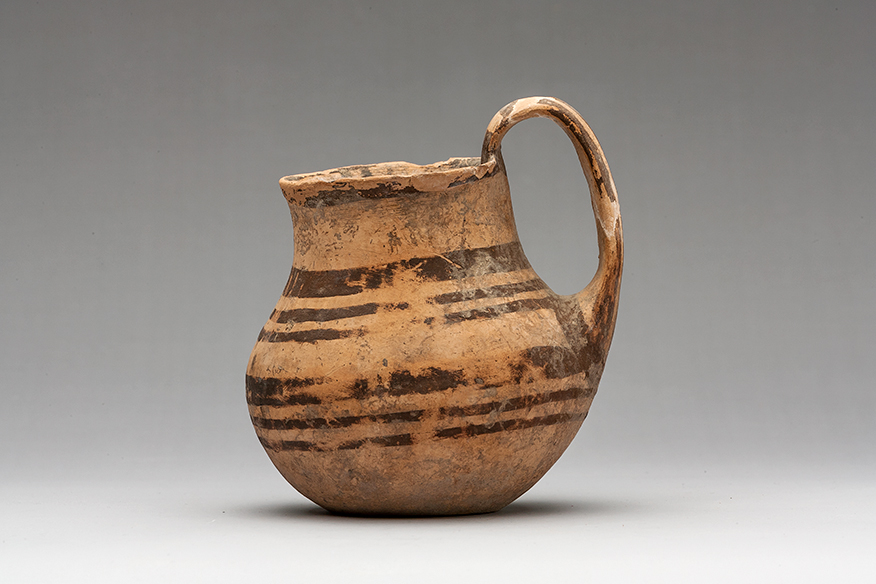Acquisition number: 2008.06
Intact but for some surface wear, some chips from the lip and a break in the handle. Fairly smooth orange-buff clay, paler at the surface.
The vase has a concave neck which runs into the rounded body in a continuous curve. Simple lip. Strap handle running from the belly to the top of the lip, rising above the level of the lip. The lip is made vertical at the junction. Well-finished, flat base.
The painted decoration is in a matt brown. There is a band over the lip, inside and out, and on the inner face of the lip there hang from it three groups of three short vertical lines (one of them at the handle junction). On the shoulder and body are two sets of broad bands with two lines below. The handle has three vertical bands terminating at a cross-band above, and, below, at a band painted around the handle-root.
Title: Round-Mouthed Jug - 2008.06
Acquisition number: 2008.06
Author or editor: J.R. Green
Culture or period: Daunian Banded Ware.
Date: Second quarter 5th century BC.
Material: Clay - Terracotta
Object type: Vessels - Jug/wine jug
Dimensions: 92mm (w) × 96mm (h)
Origin region or location: Italy
Origin city: Daunia.
Display case or on loan: 8
Keywords: Apulian, Daunian
2008.06
Round-Mouthed Jug
On loan from Mrs R. Cardin. Max. ht lip 9.6cm; diam. 9.2cm.
Intact but for some surface wear, some chips from the lip and a break in the handle. Fairly smooth orange-buff clay, paler at the surface.
The vase has a concave neck which runs into the rounded body in a continuous curve. Simple lip. Strap handle running from the belly to the top of the lip, rising above the level of the lip. The lip is made vertical at the junction. Well-finished, flat base.
The painted decoration is in a matt brown. There is a band over the lip, inside and out, and on the inner face of the lip there hang from it three groups of three short vertical lines (one of them at the handle junction). On the shoulder and body are two sets of broad bands with two lines below. The handle has three vertical bands terminating at a cross-band above, and, below, at a band painted around the handle-root.
The vase is wheelmade. Compare E. De Juliis, La ceramica geometrica della Daunia (Florence 1977) pll. 97a-b and 98, and R. Iker, Ordona VII, 2: Les tombes dauniennes (Brussels – Rome 1984-1986) 350ff, tomb 91, pl. 29 where the relevant jug (91.2) may well belong with the earlier group of material. All three examples are datable, on the grounds of the black-glaze cups found with them, to the second quarter of the fifth century BC.
Daunia in northern Apulia was a wealthy area with a strong local culture. It was also the slowest of the regions of Apulia to exhibit much Greek influence, and the manufacture of pottery on the wheel was not ubiquitous even at this period. On Daunia more generally, see the articles in M. Mazzei (ed.), La Daunia antica. Dalla preistoria all’altomedioevo (Milan 1984) and A. Neppi Modona (ed.), La civiltà dei Dauni nel quadro del mondo italico. Atti del XIII convegno di studi etruschi ed italici, Manfredonia 21-27/6/1980 (Florence 1984).
Mrs R. Cardin.
